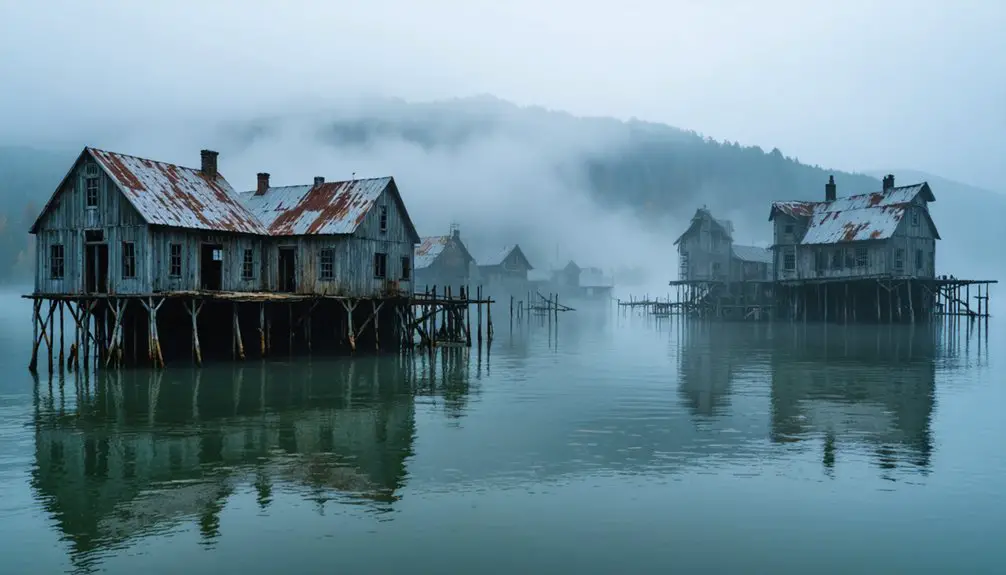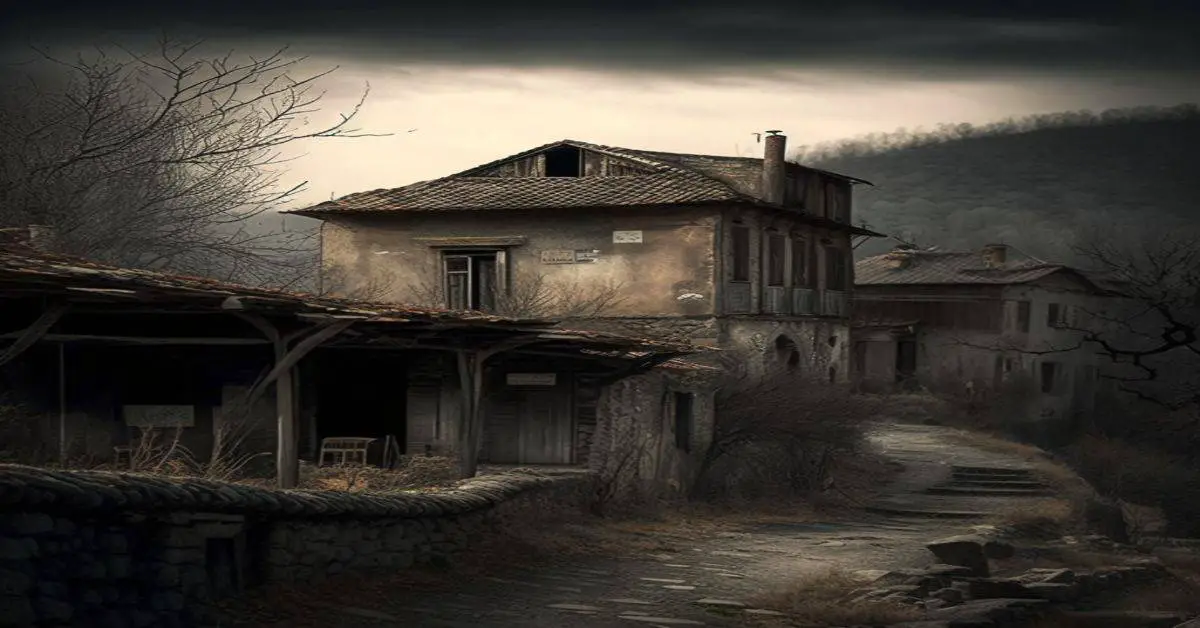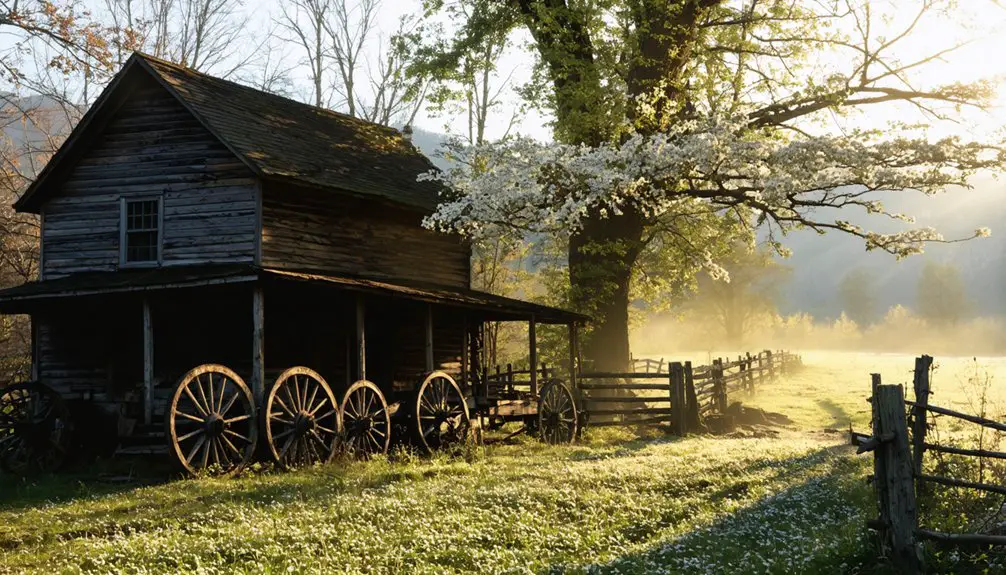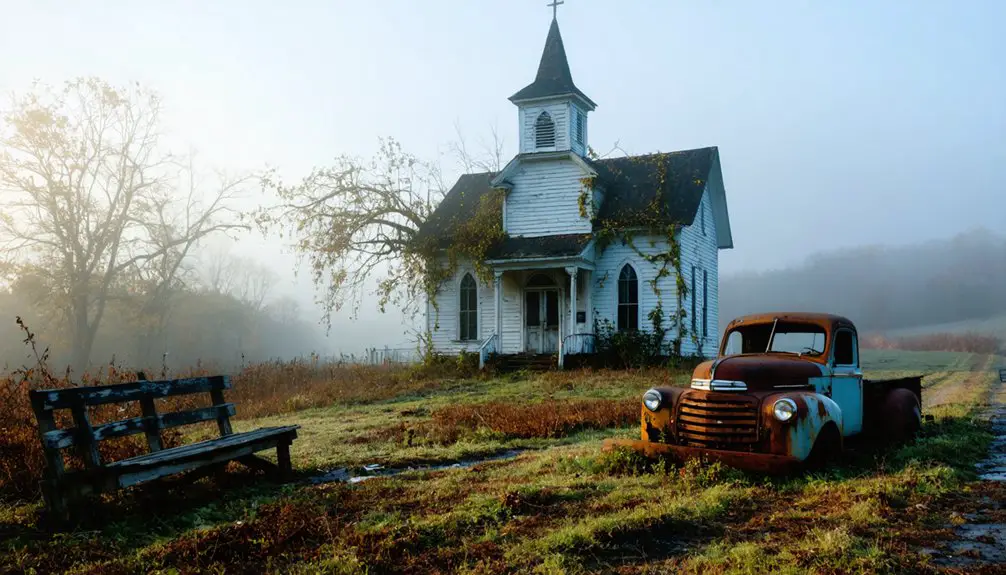Butler, Tennessee lies beneath 150 feet of water in Watauga Lake, making it one of America’s most unusual ghost towns. You’ll find the original town site, founded in 1768, was home to 600 residents until the Tennessee Valley Authority‘s dam project forced evacuation in the 1940s. Today, New Butler stands nearby, where the Butler Museum preserves artifacts from the submerged town. The community’s resilient spirit lives on through stories of “The Town That Wouldn’t Drown.”
Key Takeaways
- Original Butler lies submerged beneath Watauga Lake after TVA’s 1940s dam project forced relocation of 600 families.
- The town earned the nickname “Lost City” when it became the only incorporated Tennessee town fully submerged by TVA waters.
- During periods of low water, remnants of old Butler, including building foundations and roads, become visible 150 feet below.
- Butler Museum preserves the ghost town’s history through photographs, artifacts, and oral histories from former residents.
- The community’s spirit lives on through annual Old Butler Days festival and the relocated New Butler settlement.
The Story of Smith’s Mill to Butler
The humble beginnings of Butler, Tennessee trace back to 1768 when pioneer John Honeycutt established the first cabin and arbor shelter along Roan Creek near its confluence with the Watauga River.
The settlement history began to take shape as James Millican and Ezekiel Smith joined the frontier community, with Smith constructing an essential gristmill in 1820 that gave the growing settlement its first name: Smith’s Mill. Like the estate stewards of grand European houses, Smith managed the operations of this vital community resource. By the early 1820s, the thriving community had grown to include fifty pioneer families.
Life Before the Waters Rose
During its heyday before the TVA project, Butler thrived as a close-knit community of 600 residents, with roughly 125 homes and 50 businesses serving as the backbone of local commerce.
You’d find a town shaped by both its cultural identity and environmental challenges, where frequent floods tested the community’s resilience. The arrival of the railroad in 1902 brought new economic opportunities and growth to the town. The Watauga Academy stood as a center of learning and social life, offering advanced education including drama and music through its literary societies.
Life centered around farming, lumber, and local trade, while the town’s infrastructure supported regional commerce through established roads and bridges. The town proudly carried the name of Roderick R. Butler, a prominent leader who influenced the post-Civil War era.
Despite recurring floods in 1867, 1886, 1901, 1902, 1916, 1924, and 1940, Butler’s residents adapted and persevered, maintaining strong social bonds through their shared institutions, schools, and churches.
The TVA Decision That Changed Everything
While Butler’s residents had long endured recurring floods, TVA’s 1940s decision to build the Watauga Dam marked a permanent end to their town’s existence.
The TVA flood control project aimed to prevent the devastating floods that had plagued the region since 1867, with the 1940 flood dealing particularly severe damage to infrastructure, including the essential railroad line from Elizabethton to Mountain City.
You’ll find that the Butler community impact was profound – over 600 families were forced to relocate as their hometown became the only incorporated town ever submerged by TVA waters. Many residents established a new community called Carderview Settlement as their fresh start.
Though the dam successfully prevented future flooding and protected downstream communities, the decision sparked decades of resentment among displaced residents who’d watched their tight-knit community disperse to higher ground. The town now rests 150 feet underwater, with remnants of old Butler still visible beneath the surface.
Preserving a Drowned Legacy
Despite being submerged beneath Watauga Lake since 1948, Butler’s legacy lives on through dedicated preservation efforts at the Butler and Watauga Valley Heritage Museum.
Through historical documentation and community storytelling, you’ll discover the town’s rich heritage spanning from the 1700s through the mid-1900s, including its role in the Revolutionary and Civil Wars.
Butler’s fascinating story unfolds through historical records and local tales, revealing centuries of rich American history from revolution to reconstruction.
The museum’s collection features photographs, artifacts, and records from Old Butler, while oral histories from former residents keep the memory of daily life vivid and real.
You’ll find exhibits highlighting the prestigious Watauga Academy, which educated students until the town’s final days.
The town’s relocation required 54.9 miles of new roads to be constructed as part of the massive TVA project.
Through organized events, tours, and educational programs, you’re invited to explore this remarkable underwater ghost town‘s history, even as its physical remains rest silently beneath Watauga Lake’s 110 miles of shoreline.
New Butler’s Living Connection to the Past
The legacy of Old Butler lives on through its successor community, New Butler, established on higher ground above the submerged town site.
You’ll find remarkable examples of community resilience in the way residents maintain their connection to the past, particularly through the annual Old Butler Days festival each August.
The town’s historical artifacts tell a compelling story of preservation, with treasures like the original horse-drawn hearse and post office fixtures now displayed in the local museum. The museum educates visitors about how 650 families once called Old Butler home.
Originally known as Smith’s Mill, the town was later renamed to honor a Union Colonel who served during the Civil War.
With a population of 297 as of 2020, New Butler’s residents continue to honor their unique heritage as “The Town That Wouldn’t Drown.”
Through oral histories, preserved relics, and active community celebrations, you’re witnessing a living reflection of a community that refused to let their identity sink beneath Watauga Lake’s waters.
Frequently Asked Questions
Can Scuba Divers Explore the Remains of Old Butler Underwater Today?
You can’t reliably scuba dive to explore Old Butler’s underwater remains due to TVA regulations, poor visibility conditions, and safety concerns regarding unstable structures beneath Watauga Lake’s surface.
What Happened to Residents Who Refused to Relocate From Old Butler?
You’ll find that resistant residents ultimately had to leave through TVA’s legal property acquisition process by 1947, though historical records don’t show violent evictions or major conflicts during the relocation.
How Much Did TVA Compensate Residents for Their Properties?
You’ll find compensation details varied widely, with payments ranging from hundreds to thousands of dollars per property. TVA’s records show residents received fair market value, though many disputed initial appraisals.
Are There Any Original Butler Buildings Still Standing Above Water?
You’d expect old buildings to still stand proud, but ironically, no original abandoned structures from Butler remain above water – they were all submerged or relocated, preserving their historical significance only through artifacts.
Did Any Environmental Studies Predict Long-Term Effects of Flooding Butler?
You won’t find evidence of formal environmental assessments predicting flood impacts before Butler’s inundation. TVA’s documentation from the 1940s focused primarily on relocation efforts rather than long-term ecological consequences.
References
- https://www.youtube.com/watch?v=94P6nuyfjMQ
- https://www.thesmokies.com/underwater-ghost-towns/
- https://www.tnmagazine.org/tennessees-underwater-ghost-towns/
- https://www.onlyinyourstate.com/experiences/tennessee/dangerous-nature-spot-tn
- https://www.onlyinyourstate.com/trip-ideas/tennessee/tn-ghost-town-underwater
- https://ominous.app/browse/site/18252
- https://en.wikipedia.org/wiki/Butler
- https://www.johnsoncountytnchamber.org/towns/butler/
- https://www.tnvacation.com/east-tennessee/butler
- https://www.youtube.com/watch?v=2SK22VvXzmk



